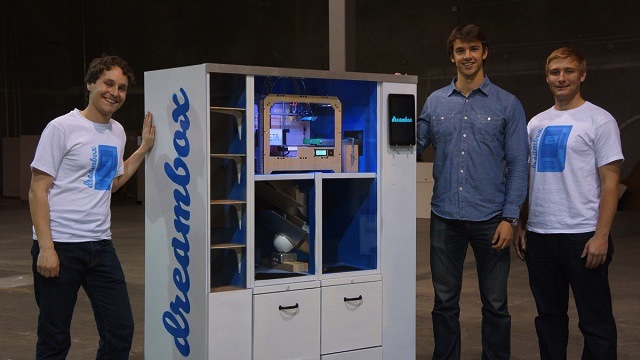As the penetration curve of 3D printers in the consumer segment continues to edge very slowly upwards, the adoptation rate could be improved by removing the veil of mystery that surrounds the sector. One solution to this issue is to introduce the tech to directly to consumers and not to just passively wait for them to pick up on the news and join the party on their own. This is where concepts like Kiosk 2.0 and the focus of today’s story come in to play. The machine of the hour – Dreambox – is a new 3D printing vending machine, designed to be placed in any setting where people – potential users – are, whether it be in a kiosk on a street corner, school or office facilities.
Like many of the more innovative approaches that have been popping up recently in the 3D printing world, Dreambox is also originally created by students. This time the foundation has been laid at U.C. Berkeley, where the team met each other in a mobile app development class in 2011. The idea for creating something new around 3D printing came from the lack of resources on campus – the lines for waiting to use the 3D printers at the Uni were painstakingly long and online 3D printing services – with their +2 week delivery times – were not ideal either, especially considering the team’s need for fast iterations of their different projects.
The solution to this problem – the core idea of the Dreambox – is quite simple, yet very clever. Have a look at the video of the process steps of using the said machine below.
Here’s how the process goes: the user uploads a preferred digital design to the machine – either online or on-site via a USB stick – or just simply chooses a flash – a pre-made, customizable digital model of an object. After this step the design is added to the queue – on the nearest Dreambox – and 3D printed. Once the process is complete, the printed object is dispensed into a locker, the user is alarmed via text message and voilà – the customer can now pick up the 3D printed goods by entering the personal code into the machine. The latter part is therefore very similar to what some postal services offer for packages – something that has been proven to be quite a functional concept already – but the most relevant aspects are the convenience and speed factors (assuming the print queue on the Dreambox is not help up by prints that take 5 days!!).
As the Dreambox’s internals are highly modifiable according to the users’ needs, a large variety of actual 3D printing hardware could be placed inside. This enables provision of a large selection of materials as well, according to the user preferences – and of course costs.
Dreambox as a concept is very appealing and understandable, but whether or not the process – and most importantly the results – are actually as smooth as portrayed remains to be seen. The speed is also a crucial factor here, as deals like the one between Mcor and Staples are introducing the print shop thinking to even larger audiences – as well as the small but ever more apparent 3D printing kiosks. But nonetheless, a niche for something like this – a low barrier introductory approach to 3D printing – is still to be filled. Without specializing in a more specific business customer segment, however, Dreambox might have to face difficult challenges before creating a true nation-wide network of these 3D vending machines.
But despite all this, until 3DP service companies are able to offer next day – or even same day – deliveries, Dreambox and other rapid 3DP service concepts have a real market waiting for them.
As ever, we’ll keep you posted on the progress.
Source: Dreambox




